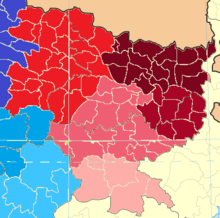Bihari languages

Red -
Bhojpuri speaking region
Pink -
Magahi speaking region
Brown(northeast part) -
Maithili speaking region
Maroon -
Angika speaking region
Bihari is the western group of Eastern Indo-Aryan languages, spoken in Bihar and neighboring states in India. Angika, Bajjika, Bhojpuri, Magahi, and Maithili are spoken in Nepal as well. The Angika, Bajjika, Bhojpuri, Magahi and Maithili speaking population form more than 21% of Nepalese population. Despite the large number of speakers of these languages, they have not been constitutionally recognised in India, except Maithili, which gained constitutional status via the 92nd amendment to the Constitution of India, of 2003 (gaining assent in 2004).[2] Even in Bihar, Hindi is the language used for educational and official matters.[3] These languages were legally absorbed under the overarching label Hindi in the 1961 Census. Such state and national politics are creating conditions for language endangerments.[4] After independence Hindi was given the sole official status through the Bihar Official Language Act, 1950.[5] Hindi was displaced as the sole official language of Bihar in 1981, when Urdu was accorded the status of the second official language. In this struggle between Hindi and Urdu, the claims of the three large native languages of the region – Angika, Bhojpuri and Magahi, were ignored.
Speakers
The number of speakers of Bihari languages is difficult to indicate because of unreliable sources. In the urban region most educated speakers of the language name Hindi as their language because this is what they use in formal contexts and believe it to be the appropriate response because of unawareness. The educated and the urban population of the region return Hindi as the generic name for their language.[6]
Languages included in Bihari group
| Language[7] |
ISO 639-3 |
Scripts |
No. of Speakers[6] |
Geographical Distribution |
| Angika | anp | Previously Anga Lipi; Devanagari | 743,600[8] | North Bihar and Eastern Bihar, North-eastern Jharkhand, West Bengal, Nepal |
| Bajjika | — | Devanagari | 8,738,000 | North-Central Bihar Eastern Terai |
| Bhojpuri | bho | Previously Kaithi; Devanagari | 38,546,000 | Western Bihar, Eastern Uttar Pradesh, Northwestern Jharkand, Northern Chhattisgarh, Northeastern Madhya Pradesh, Central Terai, and Southern Nepal |
| Caribbean Hindustani[9] | hns | Latin, Devanagari | 166,000 | Trinidad and Tobago, Suriname, Guyana, Jamaica, and other parts of the Caribbean |
| Fiji Hindi[10] | hif | Latin and Devanagari | 460,000 | Fiji Islands |
| Kudmali | kyw | Devanagari, Chis (also suggested as its possible script) | 37,000 | Eastern Jharkhand, West Bengal |
| Magahi | mag | Previously Kaithi; Devanagari | 20,362,000 | South Bihar |
| Maithili | mai | Maithili variant of Eastern Nagari script, Devanagari | 33,890,000 | Northern Bihar, Official Status in  Madhesh, Nepal Madhesh, Nepal |
| Majhi | mjz | N.A | 21,841 | Eastern Bihar, Nepal |
| Musasa | smm | N.A | 50,000 | Eastern Bihar, Nepal |
| Panchpargania | tdb | Devanagari, sometimes Bengali & Kaithi | 274,000 | West Bengal Jharkhand Assam |
| Sadri | sck | Devanagari | 165,683 | Jharkhand Bihar and Bangladesh |
| Khortha | sdr | Eastern Nagari script, Devanagari | 1,965,000 | Northern Jharkhand |
| Surjapuri | sjp | Devanagari | 273,000 | North-eastern Bihar |
See also
References and footnotes
- ↑ Hammarström, Harald; Forkel, Robert; Haspelmath, Martin; Bank, Sebastian, eds. (2016). "Bihari". Glottolog 2.7. Jena: Max Planck Institute for the Science of Human History.
- ↑ "The Constitution (Ninety-Second Amendment) Act, 2003". National Portal of India. 7 January 2004. Retrieved 11 April 2015.
- ↑ Damani, Guarang (2015). "History of Indian Languages". Die-hard Indian. Retrieved 11 April 2015.
- ↑ Verma, Mahandra K. "Language Endangerment and Indian languages : An exploration and a critique". Linguistic Structure and Language Dynamics in South Asia.
- ↑ Brass, Paul R. (8 September 1994). The Politics of India Since Independence (Second ed.). Cambridge University Press. p. 183. ISBN 9780521459709. Retrieved 11 April 2015.
- 1 2 Cardona, George; Jain, Dhanesh, eds. (11 September 2003). The Indo-Aryan Languages. Routledge Language Family Series. Routledge. p. 500. ISBN 978-0415772945.
...the number of speakers of Bihari languages are difficult to indicate because of unreliable sources. In the urban region most educated speakers of the language name Hindi as their language because this is what they use in formal contexts and believe it to be the appropriate response because of lack of awareness. The uneducated and the urban population of the region return Hindi as the generic name for their language.
- ↑ Bihari Languages
- ↑ http://www.ethnologue.com/language/anp
- ↑ "Form of Bihari with Bhojpuri and Awadhi influence spoken by Indo-Caribbeans."
- ↑ "Form of Bihari, Bhojpuri, and Awadhi, spoken by Fiji Indians"
External links
